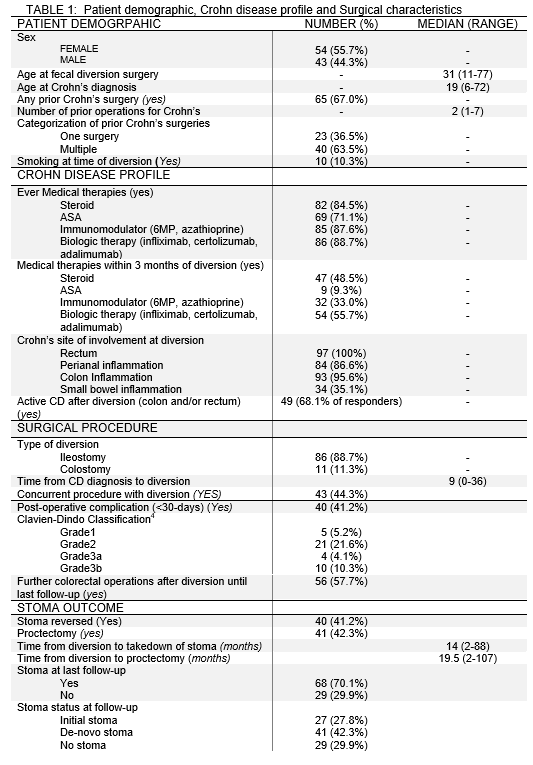P446 Long-term Clinical Effectiveness And Stoma Outcome Of Fecal Diversion In Refractory Crohn’s Proctitis
Benammi, S.(1);Perry, W.R.(1);Calini, G.(1);Abdalla, S.(1);Shawki, S.F.(1);Larson, D.W.(1);Mathis, K.L.(1);
(1)Mayo Clinic, Colon and Rectal Surgery, Rochester, United States;
Background
Proctectomy is often recommended when Crohn’s proctitis becomes refractory to medical therapy. However, some surgeons offer a temporary diverting stoma in an effort to avoid a permanent stoma. The long-term efficacy of this approach is not well-established. Our aim was to determine the long-term effectiveness of fecal diversion in patients with refractory Crohn’s proctitis.
Methods
This retrospective study included all patients with Crohn’s proctitis who underwent formation of a diverting ileostomy or colostomy for refractory disease from 1998 to 2019 in Mayo Clinic Rochester MN. Outcomes were disease recurrence, rate of stoma closure, and proctectomy. Univariate comparisons among categorical variables were performed with Pearson’s Chi-square and continuous variables using the student t-test. The cumulative probability of stoma closure was performed with a Kaplan Meier log-rank analysis. Multivariable analysis of risk factors for proctectomy and permanent stoma was achieved with logistic regression.
Results
Ninety-seven patients (55.7% female) were included. Ileostomy was the most common stoma type (88.7%, n=86), and colostomy was (11.3%, n=11) (Table.1). Median follow-up was 4 years (range 0-14). Active Crohn’s at follow-up was reported in 68.1%. Only 41.2% of patients underwent attempt at stoma reversal, and 42.3% required a proctectomy (median 19.5 months after diversion). At last follow-up, 29.9% were stoma-free, 42.3% had a new permanent stoma, and 27.8% had the original diverting stoma (Fig.1). The multivariable predictors of proctectomy and permanent stoma were the recurrence of active CD after diversion and the need for other CD-related surgery following stoma creation (Table.2). The limitations of the study are its small sample size and its retrospective nature. The cumulative probability of stoma closure was performed with a Kaplan Meier log-rank analysis (Fig.2).




Conclusion
Diversion is effective at alleviating symptoms of Crohn’s proctitis in selected patients but does not significantly change disease outcome. Only a small number can avoid a long-term stoma.


